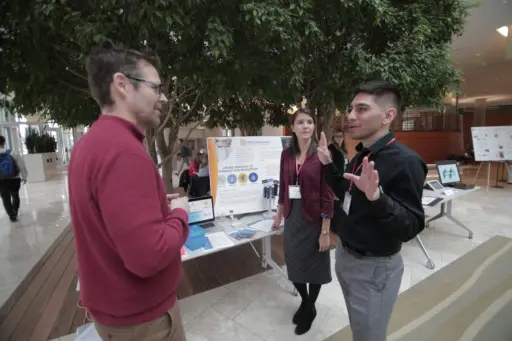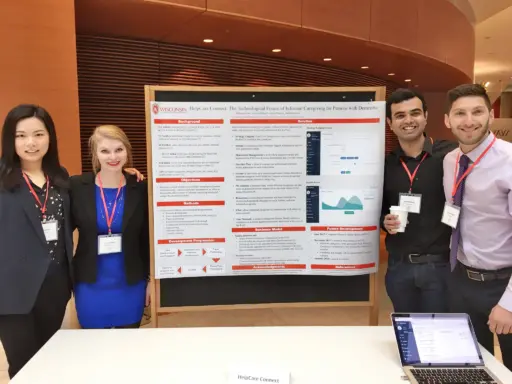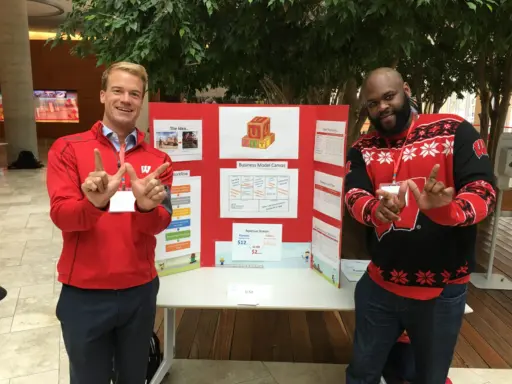A startup that harnesses genetic sequencing techniques to rapidly detect pathogens in drinking water. An advanced 3D printer for quickly printing high-quality, high-quantity metal parts. A device that could improve healthcare providers’ ability to diagnose and treat post-operative arrhythmias in patients following cardiac surgery.
These are just a few of the inventions that students presented to judges during the Transcend Madison Innovation Competition: Powered by Qualcomm, March 29-30, 2017.
 Members of Pathogenomica explain their technology during a poster session at the 2017 Transcend Madison Innovation Competition: Powered by Qualcomm. Pathogenomica is a startup that harnesses genetic sequencing techniques to rapidly detect pathogens in drinking water. Photo: Stephanie Precourt.
Members of Pathogenomica explain their technology during a poster session at the 2017 Transcend Madison Innovation Competition: Powered by Qualcomm. Pathogenomica is a startup that harnesses genetic sequencing techniques to rapidly detect pathogens in drinking water. Photo: Stephanie Precourt.
More than 30 teams of students from schools and colleges across the University of Wisconsin-Madison vied for thousands of dollars in prize money to fund their ventures. The competition, which is in its second year, was part of UW-Madison’s Innovation Days, a celebration of creativity and innovation across campus. And while innovation is central to the curriculum in the UW-Madison College of Engineering and in other disciplines at UW-Madison, the competition presents all students yet another opportunity to translate their knowledge, skills and ideas into products that benefit society.
For students working on HelpCare Connect, a web-based platform to assist family caregivers of people with dementia or Alzheimer’s disease, the competition provided an opportunity to present an early iteration of their platform and to receive valuable feedback from industry professionals. The team is developing a website and mobile app that will enable informal caregivers, who are often disconnected from each other, to better communicate and document information related to the person with dementia. Additionally, as caregivers document a patient’s dementia-related behaviors over time, the platform will use machine learning to generate caregiver strategies that are tailored for the specific patient.
The students on the team are members of Industrial and Systems Engineering Assistant Professor Nicole Werner’s lab, and they’re passionate about transferring knowledge generated from their research in Werner’s lab into a website and app that can help improve people’s lives.
“Informal caregivers of people with dementia face very difficult challenges everyday in caring for their loved ones,” says Tianning Chen, a member of the HelpCare Connect team and a master’s student in the Department of Industrial and Systems Engineering. “There’s no product like this on the market that can help ease burdens on caregivers, and we think there should be.”
 Members of the HelpCare Connect team, from left: Tianning Chen, Rachel Zenker, Ashish Shenoy and Connor Pardell.
Members of the HelpCare Connect team, from left: Tianning Chen, Rachel Zenker, Ashish Shenoy and Connor Pardell.
Team member Rachel Zenker, a junior majoring in industrial engineering, says the interdisciplinary collaboration among team members has been instrumental in developing the product. In addition to Chen and Zenker, the team includes MBA student Connor Pardell and Ashish Shenoy, a computer science master’s student.
Zenker says having people with diverse areas of expertise working closely together has provided valuable perspective on key areas for the venture, such as strategies for bringing the product to market.
“The team did affinity diagramming initially, just to get all our ideas out there,” Zenker says. “We all had different colored Post-It notes for ideas, and it was very clear who was thinking in what mindset. I could really see how important it was to have certain people there to contribute those other components that we weren’t really thinking about before.”
For Brandon Shields, the inspiration for his venture arose from a need in his own life. Shields, a single father, moved to Wisconsin to enroll in the MBA program in the Wisconsin School of Business, and he quickly experienced frustration with trying to schedule childcare on a fluctuating basis. So, Shields teamed up with fellow MBA student Scott Maurer to develop U-Sit, a service for people affiliated with UW-Madison that matches parents with sitters and allows for flexible scheduling arrangements.
Maurer says participating in the Transcend Madison Innovation Competition was a great opportunity and learning experience for the team.
“This process has been extremely valuable to us,” Maurer says. “It has given us an opportunity to practice our pitch and talk to future investors, and we’ve identified some ways we can improve on presenting our project.”
 Scott Maurer (left) and Brandon Shields of U-Sit
Scott Maurer (left) and Brandon Shields of U-Sit
Transcend Engineering—a student organization dedicated to fostering student innovation in any major—hosts the competition. The group also organizes talks and workshops, such as a practice pitch session and a primer on protecting intellectual property, for students participating in the competition.
Maurer says these multiple events help students from across campus meet and form connections around a shared interest in entrepreneurship and innovation. “It’s great that Transcend is able to build this community, even before the big competition happens, and that’s been awesome for establishing relationships,” Maurer says.
Shields says that, as a student in the School of Business, it has been very rewarding to make connections with people in the College of Engineering and to branch out beyond traditional academic silos. “There are a lot of great engineers here who could use some marketing help,” Shields says. “And there are a lot of marketers who could use some engineering help. Events like this help bridge those gaps.”
At the awards ceremony, Steve Halter, senior director of engineering at Qualcomm and one of the judges in the competition, praised the students’ hard work and ingenuity, noting that deciding on the winners was very difficult because there were so many exceptional projects.
“It’s very awe-inspiring to see all the ideas, innovation and the problems you’ve identified and chosen to take on, as well as the amount of time you’ve dedicated and the effort and passion you’ve shown,” Halter told the students.
The 2017 competition winners:
- First place: Linectra, a high-resolution and high-throughput 3D metal printer, won $10,000. Linectra’s patent-pending technology enables rapid production of big parts or simultaneous production of many small parts faster than existing printers.
- Second place: Cairo Beverage won $8,000. Cairo’s first beverage line is inspired by Middle-Eastern/Mediterranean tea-based drinks. The company’s product will appeal to consumers who want a refreshing, flavorful drink with none of the sugar of traditional soft drinks.
- Third place: SwopShop won $5,000. SwopShop is a mobile app that gives users a platform to buy, sell and trade belongings in a fun swipe format. Users have the ability to barter back and forth until both parties agree to the terms of trade.
The students’ entries were judged on the novelty of their idea, their prototype, their business model, their execution and their pitch. In addition to Halter, judges for the 2017 competition included Heather Wentler, executive director at the Doyenne Group; Ben Stanley, director of gBETA Milwaukee at gener8tor; and Jillana Peterson, a member of Zendesk’s corporate social responsibility team.